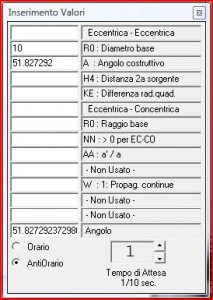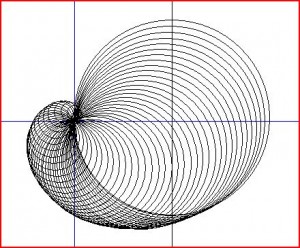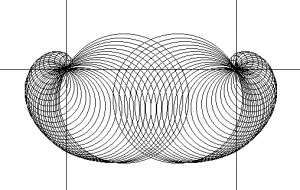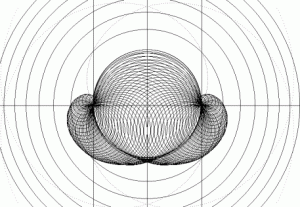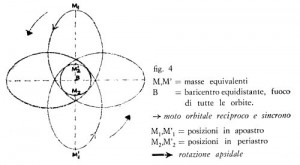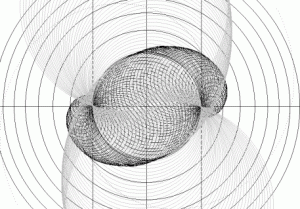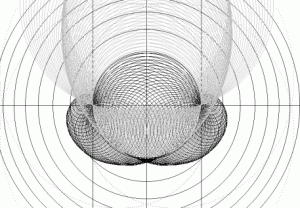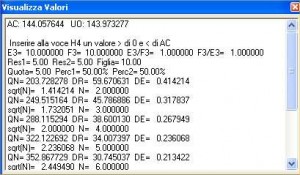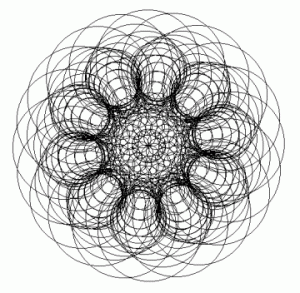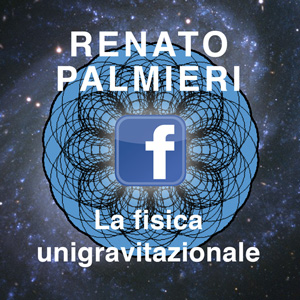Chapter 3.6 Fenomeni universali di campo: “undulatory composition”, “pulsazione” e “interincidenza”.
Premessa.
A) The “undulatory composition”: from photonic waves to galactic waves. (part One).
§ 1. The undulatory composition, ie the spherical connection between waves of different gravitational sources, is only possible because the primary source (the photon) is a source of eccentric propagation.
This is an extraordinary faculty of gravitational propagation, which is always under everyone’s eyes, in natural structures which are the effect and of which no physicist and no naturalist has so far realized.
We have already observed that if the primary sources induced concentric propagations in the ether, such as those present in the conventional physical image, such waves could only make reciprocal waves intersect, but not bring them to coincide geometrically in space over the entire spherical surface. Therein lies the test of “teleonomy“, or of the finality of gravitational laws.
Without spherical composition the progressive enlargement and the relative intensification of gravitational waves, from photonic waves to those conveying galaxies, would not be possible.
However, this phenomenon, in order to become, from theoretically possible in geometric seat, diffusely real in gravitational events, we need that the gravitational sources have spatial positions of a sufficient mutual stability, ie, that the relative speeds among the interacting sources are not too high: if different, the occurrence of the phenomenon, although possible, would be too rare to produce significant effects.
To achieve this prerequisite provides the gravitational mechanism of orbiting. The orbiting is the normal result of the dynamic equilibrium between centripetal and centrifugal attractions due to the vortex effect of the eccentric propagation.
§ 2. We specify some general properties of gravitational waves, in addition to what already has been said of them in other sections of our site and in this same, previously.
Their existence is proved by what, very improperly, could be called their “fossil mold”, ie by their structuring effect, imprinted in natural forms. Waves of electromagnetic range occur not in itself, but in their particle loading, which draws the profile in the tools of reception.
It is, at this point, of paramount importance to avoid confusion with the traditional concepts that, in fact, confuse them with their instrumental phenomenology. In this one, the terms “wavelength”, “reflection”, “refraction”, “interference”, etc.. should be reported to the only notion that mainstream physics has in an only empirical way, and that is the geometry of the stream scanning of particles channeled by gravitational waves.
Hese, in fact, being – as you pointed out several times – of intermaterial nature, once generated with the mechanisms we are describing, are absolutely unchangeable: they do not suffer, then, reflection, refraction, interference in the conventional sense, and so on. But these phenomena relate to waves that seem the continuation of the original ones, while they are entirely new, originating from corpuscular interactions that occur gradually in the involved matter.
There is, thus, a relationship, but not identification, between the official “wavelength” and the actual one of the gravitational propagation, as we shall see later.
§ 3. Let us now show analytically the geometric-mathematical and functional process, through which, in spherical composition, photonic waves increase gradually until they reach such gravitational extent and intensity to become a vehicle of galaxies and galaxy clusters.
Let’s start from the conveying function of the gravitational propagation that originates in the photon. Reserving to the Sez. IV the description of the primitive mechanism of gestation of the waves inside the photonic structure, we begin the discussion here since the emission of waves by the photon.
Each photon emits with a specific frequency, which will be discussed in sez.6, spherical waves which are the only possible way – through arcs and intersections – from any other photonic center in the direction of the issuing one, with a mutual whirling motion determined by eccentric and spiral geometry of the succession of waves produced by each elementary particle in the ether.
But it is this very special geometry to give the propagation arising from the photon its extraordinary, unimaginable compositive power, of which we are talking about and whose verification we rely on, by OLOPOIEMA, our readers.
§ 4. Suppose two photons in mutual orbiting, because in a dynamic equilibrium between the mutual attraction and that of all other photons outside their binary system.The two main undulatory configurations of orbiting among equintense particles as two photons are shown in fig.10 and 11; of these ones we immediately give the construction method, to highlight the phenomenon of “composition”.
Let’s say first that all axes – horizontal and vertical – that appear on the screen have the only function, crossing themselves, to locate the barycentric points of propagation, which are developed and are displayed according to their equatorial projection.
§ 5. Readers should now activate, in the menu GRAFICI by OLOPOIEMA, the subprogram COMPOSIZIONE. The window INSERIMENTO VALORI is divided into two parts, marked by two different titles: the higher is about the composition between two eccentric propagation; the bottom draws the composition between eccentric and concentric propagation (it is impossible, as we know, every composition between two concentric ones). The deviator W, which will be said, belongs to both.
In the EE (short for eccentric-eccentric, call the other EC) enter the following data:
R0 = 10 (example value of the photon ray, corresponding to the diameter of the emitted wave);
A = 51.827292 (constructive angle, in degrees, of the spiral of photon propagation: each logarithmic spiral is determined by the acute angle basis of right triangle inscribed in the spiral itself; to that corresponds, mathematically, according to the cosmological equation, a particular relationship a’/a between two interacting gravitational sources: the interchange between the two values is automatically reported in the last rectangle of the window by typing the value of a’/a in the first rectangle or of A in the second one; for the photon, A = arccosφ , corresponding to a ‘/ a = 0. Reset all other values. Implement below the option ANTIORARIO.
You have now the vertical axis slightly to the left of the median of the screen, the horizontal axis right in the middle of the screen. Clicking many times AVANTI you will see the issue and the succession of waves rotating around the center of a punctiform photon. Accelerate the process by clicking PLAY (the speed of the design can be adjusted by varying the TEMPO DI ATTESA, waiting time, in tenths of a second, bottom of the window): the propagation will stop after a rotation of 360 ° and a new barycentric axis will mark the center of the last wave (the oldest one, although designed last).
A new window, VISUALIZZA VALORI, Show Values, appears in which you are invited to assign freely a distance H4 to a second source, which must interact with the first, putting himself in the AC section, ray of the last wave, between the center of the wave and the antipode of the photon. On this occasion, we suggest the data, but you will see later that the composition occurs for any distance you determine, within that purely conventional limit inherent the available space on the screen. So sign up for H4 in the window of the input the value 144.05764, almost equal to AC (in this way we place the second source at a diametral distance from the first one);
then click a few steps of AVANTI to see clearly what happens, and then accelerate the process with PLAY. (The exchange between PLAY and AVANTI can always be done to slow down or speed up any process.)
Please note that The AC values (distance between the second and third axis) and UO (distance between the first two axes) should coincide in the case of two photon sources: the slight difference is created here by the approximation of the value of the constructive angle.
Two photonic propagation are meeting along a common equatorial plane: you will see the waves first intersecting themselves, passing through the situation of fig.10 a), then bring to a complete spherical coincidence (circular in the projection on the plane of the screen), represented in fig .10 b). The time of composition is marked by the emergence of a new barycentric axis cutting the horizontal one in the center of the ” composed wave.”
From two sources, two spirals of Archimedes originate, which follow the shift in the counter-clockwise rotation way of the gravitational intensity points of a third propagation, “propagation daughter.” This is manifested by concentric waves, which expand to equal increments of area in equal times, ie, with radii proportional to the square roots of integer numbers (as in the so-called “Newton’s rings” of common interference fringes). The counterclockwise rotating pulse of the “parent” waves imparts a spiral motion of the punctual values of gravitational intensity along the surface in expansion of the concentric “daughters” wave: the movement takes place in radial increments proportional to the angles of rotation, then according to a spiral of Archimedes.
In figg. 10 a) and 10 b) the two propagations in equatorial composition are polarized in parallel: both are counterclockwise, ie viewed from the North of their polar axis. This (not to be confused – as mentioned – with the axis of intersection of the screen) is perpendicular to the plane of the screen in the barycentre of each propagation, represented by the center of the photon, around which the propagating waves rotate. The North of both axes is above the screen and the South, below.
§ 6. With the same procedure described in the previous paragraph for figg.10 a) and 10 b) and with the same input values, with the only difference of the option ORARIO instead of the other one below in the window, you will see to repeat the phenomenon of the composition in figg.11 a) and 11 b).
In fig.11 the same two photonic propagations are polarized in antiparallel: the left is counterclockwise, therefore, seen from the North and the other one is clockwise, that is seen from the South. The two axes are antiparallel, reversed polarity: the axis of left has North over the screen and South below; it is the opposite for the right axis.
The expansion of concentric waves is now led by two pairs of spiral of Archimedes. The intensity points undergo a counterclockwise rotating pulse from the first source and in a clockwise sense from the second: hence their splitting from the two sources and their retracted and controversial path along two counterclockwise spirals and two clockwise..
§ 7. The undulatory situation presented in figg.10 and 11, for which waves of a propagation go spherically to coincide with the waves of the other one in the space separating them, is not constant during the mutual orbital revolution shown in fig.12, depending on the variable distance between the two particles. It occurs with a different period from the one of the primitive frequency of the photonic emission, giving rise, from the wave of composition, to a concentric “propagation daughter” having a frequency different from that of the parent particles.
The current physics, when it speaks about photon, it thinks about it on the run in space at a speed of 300,000 km/s, which is that of light. It would mean to believe, considering the electrical phenomena, that only free electrons exist, responsible for electricity, and not even the ones linked in normally stable systems, like atoms. The unigravitational physics says, however, that the photonic particle is universal and unique component of the matter and that, consequently, it is found equally in all the structures and natural phenomena, bound in complex systems or fleeing from them in the events of deconstruction and particle decay. It would be interesting that physicists let us to know, when they light a match, from where photons emitted by the flame splash out, if not by structures that have contained them, in the heart of the reagents atoms, in a stable even if invisible form.
In the mutual orbiting between two photons described in fig. 12, they behave just like, at an extremely complex level, two hydrogen atoms in the molecule of ortho-hydrogen (fig. 10) and in the para-hydrogen (fig.11). In the first case, the hydrogen nuclei rotate in the same way and their axes have parallel direction; in the second, they rotate in the opposite direction and with the axes in the antiparallel direction.
This same analysis enables us to understand the difference between the interactivity of a system which, with a terminology similar to the previous, we will call “orto-photonic”, similar in the infinitesimal to a magnet with strong parallel polarization, and a “para-photonic, ” antiparallel polarization” and then interactively ” neutral “: the latter will just be the solution of that natural mystery that physics calls neutrino, especially in relation to its huge capacity of penetration and crossing of matter. Obviously, the ortho-photon pair will represent nothing but an isomer of the usual particle, to which is given the generic name of photon. Different ways of gravitational aggregation of photons explain the different types of neutrinos and the mass differences discovering now between them, being the so-called “massless” of photons and neutrinos one of the many theoretical nonsense of contemporary physics.
§ 8. In figg.10 b) and 11 b) the two parent propagations are blocked by the program at the time of the composition in order to highlight the phenomenon. In fact, as we know, they come out only by the composition depleted of part of their gravitational intensity in favor of propagation daughter, then continuing in the space with unchanged geometry.
Repeat, in fact, the design of fig.10 b) and fig.11 b) with the same inputs, adding only the value 1 for the deviator W, which serves to continue in the space the three propagations: the two photonic parent (which continue in gray) and the concentric daughter: you have figs. 13 and 14.
§ 9. Now open the window VISUALIZZA VALORI, going back to its beginning (fig. 15). Then write down three lines of values that come after “Inserire …”.(The next lines relate the geometric values of concentric daughter and we’ll talk about at the time.)
With E3 and F3 we denote the conventional values of the gravitational intensity of the two interacting sources, in the order they appear on the screen. The program sets conventionally the proportionality of these values with the diameter of the primitive wave of each propagation. We reiterate that this is a purely conventional device, useful to provide geometric and mathematical evidence to the results, but without actual correspondence in nature.
Calling D3 the sum E3 + F3, we anticipate from the cap.3.12 the universal formulas dictated by the law of “gravitational distribution”, for the redistribution of the intensity of the wave of composition between the residual parent propagations and the primitive wave of daughter propagation. The symbols in the window are the following, besides the ones already mentioned:
Res1 and Res2 are the residual intensity of the first and second propagation after the composition;FIGLIA (Daughter) is the intensity of the newborn daughter propagation;QUOTA (Share) is the equal share that each of the two parent propagations provided the daughter and therefore is always equal to FIGLIA/2; and Perc1 and Perc2 are the percentage of E3 e F3 in D3, which is preserved vectorially even in the daughter, regardless of the equality of the absolute share paid by each parent.
It will be universally:
Res1 = E32 / D3
Res2 = F32 / D3
Figlia = 2 * E3 * F3 / D3
Quota = E3 * F3 / D3
Perc1 = 100 * E3 / D3
Perc2 = 100 * F3 / D3
§ 10. These formulas say – with easy verification of the calculation – that in the case of the equintensity between the two parent sources – such as here between two photons – each propagation gives to its daughter the half of its strength and it comes from the composition with the remaining half, while the daughter was born with its own intensity exactly equal to the original of each of the two parents.
No one can fail to see that already now it is anticipated the phenomenon of cell meiosis (gametogenesis) and of the recomposition of the genetic heritage in the zygote, from which procreation is originated.
Let us give conventionally to the primitive gravitational intensity of the photonic wave the value of 10, equal in E3 and F3, whose mutual relation is 1. We read, then, in the window, the residual values equal to 5 of both the original propagations and the share of contribution of each to its daughter, whose intensity returns equal to 10. The percentage of E3 e F3 in D3 is 50%.
§ 11. If the phenomenon of undulatory composition stopped to this situation, in the universe there would be only three categories of gravitational propagations:
– Pure Photonic propagations (eccentric), with waves of intensity equal to 10;
– Residual photonic propagations (eccentric), with waves of intensity equal to 5;
– Composed propagations (concentric), with waves of intensity equal to 10.
This would, obviously, involve the impossibility of any gravitational increase, since any further composition among eccentric propagations would give in the daughter at most a value of intensity equal to 10, and continuous decreases below that value in the residual propagations. The same would happen in the compositions between eccentric and concentric, the latter also having a common value of 10. In the universe, therefore, no wave of composed propagation could have a value of intensity higher than the primitive photonic one.
And in the contrary, as we shall see, an extraordinary mechanism of accumulation intervenes, which brings the intensity and the size of the waves of composition to grow continually over photonic levels, up to – as we have repeatedly stated – the gravitational power of waves conveying galaxies and galaxy clusters.

